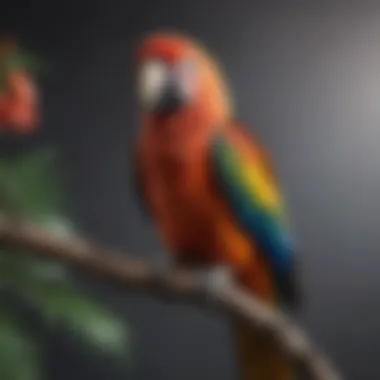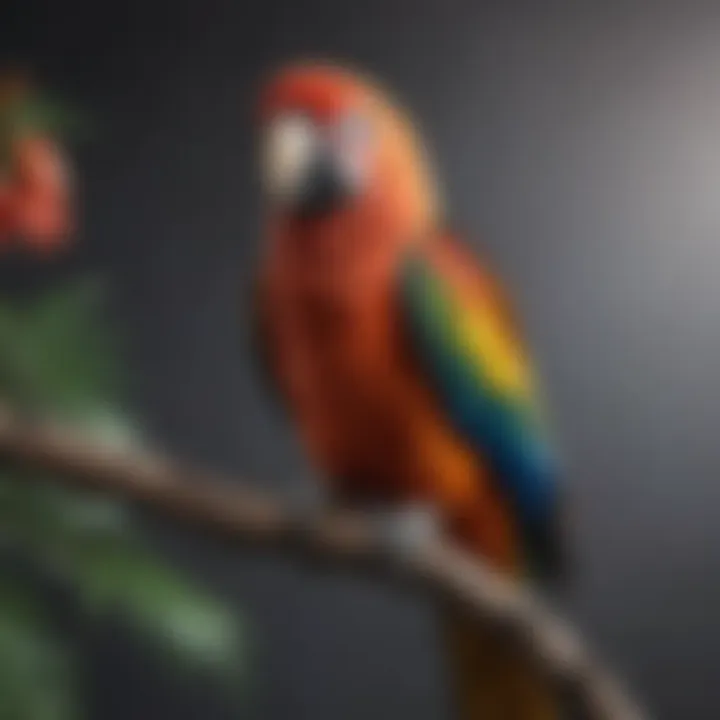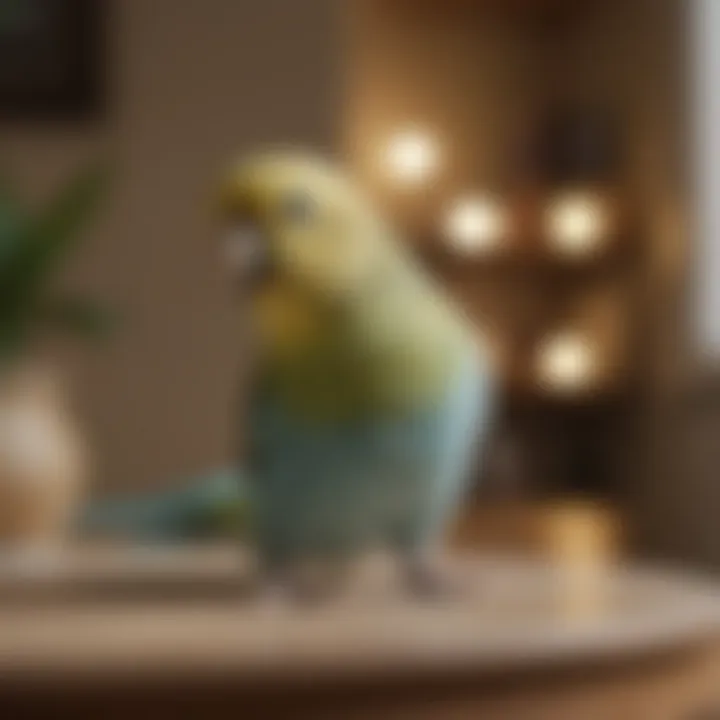Discovering the Most Enchanting Talking Birds for Pets


Intro
Talking birds captivate many with their ability to mimic human speech and engage in social interactions. The choice of a talking bird can be pivotal for pet owners, as each species brings distinct vocal talents and personalities. Understanding their needs and behaviors is essential for fostering a sustainable human-bird relationship. This article aims to explore various talking bird species and provide insights into their compatibility with different lifestyles.
Understanding Your Pet
Pet Behavior Basics
Understanding bird behavior is crucial for potential pet owners. Birds are highly social animals and thrive on interaction. They often display behaviors such as vocalization, preening, and exploring their environment. Observing these behaviors can help owners develop a stronger bond with their feathered friends.
Common Breed Characteristics
Different talking bird breeds exhibit unique traits. For example, African Grey Parrots are known for their intelligence and extensive vocabulary, while Budgerigars are more playful and less demanding. Understanding these characteristics helps in finding the right species that aligns with an owner’s lifestyle. Here are some common traits:
- Size: Smaller birds like Lovebirds require less space than larger ones like Amazon Parrots.
- Vocalization: Each breed has different vocal abilities and tendencies.
- Social Needs: Some species need more companionship and stimulation than others.
Species-Specific Needs
Species-specific needs should guide pet ownership decisions. For example, Macaws require ample space and exercise compared to Cockatiels, which are adaptable to smaller living environments. Recognizing these needs plays a significant role in ensuring that the bird thrives in a new home.
Pet Care and Maintenance
Feeding Guidelines
Proper nutrition is the cornerstone of a bird's health. Most talking birds thrive on a diet of pellets, seeds, and fresh fruits and vegetables. Consulting an avian veterinarian can help in determining specific dietary requirements based on breed and age. Here’s a general guideline:
- Pellets: Approximately 60% of the diet
- Seeds: About 20% for treats
- Fruits and Vegetables: The remaining 20%, varied and fresh
Grooming Essentials
Regular grooming is necessary for the well-being of talking birds. This includes nail trimming, beak care, and feather maintenance. For feathers, baths or misting with water can help keep them clean and healthy. Trimming nails should be done carefully to avoid injury.
Hygiene Practices
Maintaining a clean environment is vital for a talking bird's health. Daily cleaning of perches, toys, and food containers is important. The cage should be deep-cleaned regularly to prevent parasites and bacteria. This ensures a healthy living space.
Training and Development
Basic Commands and Skills
Training talking birds can be rewarding. Start with simple commands like “step up” or “no.” Repetition and consistency are crucial. Positive reinforcement, such as treats, can motivate their learning process. Birds are quick learners, but patience is essential.
Behavioral Training Techniques
Using behavioral training techniques will help to reinforce good habits. For example, clicker training can effectively teach birds to associate sounds with specific actions. Regular practice increases their cognitive skills and improves their bond with their owners.
Addressing Common Behavior Issues
Common issues like excessive noise or feather plucking can arise. Understanding stressors, such as loneliness, can mitigate these problems. Redirecting attention through engagement or toys can also be effective. Identifying triggers is key to providing better care.
Health and Wellness
Routine Vet Check-ups
Routine veterinary visits are crucial for monitoring your bird's health. An avian vet can identify underlying health issues before they become severe. Annual check-ups help ensure the bird remains in peak condition.
Vaccination Needs
Not all birds require vaccinations, but consult with a vet for specific needs based on breed and exposure risk. Vaccination can help prevent certain diseases potentially harmful to birds.
Recognizing Signs of Illness
Being vigilant about your bird's health is essential. Signs of illness may include changes in vocalization, lethargy, or changes in eating habits. Early detection often leads to better health outcomes.
Enrichment and Activities
Indoor vs.
Outdoor Activities
Engagement is critical for a bird's happiness. Indoor activities can include teaching tricks or providing stimulating toys. Outdoor time, when safe, offers fresh air and new experiences, enhancing their quality of life.
Interactive Toys and Games
Interactive toys can provide mental stimulation. Look for puzzle feeders or toys that encourage problem-solving. These activities keep them occupied and reduce boredom.
Socialization Opportunities
Socialization is imperative for happy birds. Introduce them to different people, environments, and even other birds when possible. This practice helps them develop better social skills and reduces anxiety.
Important: Ensuring a variety of activities prevents behavioral issues associated with boredom and isolation.


Prolusion to Talking Birds
The topic of talking birds offers a unique insight into the blend of companionship and intelligence. These birds are known not just for their beauty but also for their exceptional vocal abilities. Understanding their communication can enhance the bond between pet owner and bird. When selecting a pet bird, knowledge about the vocal capabilities and societal behaviors of different species becomes crucial. This understanding is essential for enhancing interaction and companionship.
Understanding Avian Communication
Communication among birds is complex yet fascinating. Birds utilize a variety of sounds to convey emotions, needs, and social interactions. The ability to mimic human speech adds an extra layer of intrigue. Birds, such as African Grey Parrots and Budgerigars, are particularly talented in this regard.
Understanding how birds communicate in their natural environments helps potential owners appreciate their needs. Recognizing the differences in vocal styles between species aids in setting realistic expectations when welcoming a talking bird into the home.
Key aspects of avian communication include:
- Vocal Mimicry: Some species have a remarkable talent for mimicking the sounds they hear around them, including human speech.
- Social Signals: Birds communicate with each other through body language and various calls, indicating everything from alarm to contentment.
- Learning Environment: The environment plays a significant role in how well a bird communicates. Social interaction is critical, as it encourages vocalization.
The Appeal of Talking Birds
Talking birds attract many pet lovers for a variety of reasons. Their engaging nature lends itself to creating a lively household atmosphere. The ability of these birds to replicate speech and sounds provides entertainment and a sense of connection.
The appeal includes:
- Companionship: Many people seek companionship in pets, and talking birds can offer a unique bond that is both interactive and fulfilling.
- Intellectual Stimulation: Talking birds require mental engagement, which can be intellectually stimulating for both the bird and the owner.
- Social Interaction: The presence of a talking bird often sparks conversation and socialization, not only between the owner and pet but also among family and friends.
“Many cultures have revered talking birds as symbols of intelligence and companionship.”
In summary, understanding the significance of talking birds is essential for prospective pet owners. Through their vocal abilities and communicative nature, they promise companionship and an engaging experience. Therefore, further exploration into different species can enhance the experience of owning one of these unique companions.
Criteria for Choosing a Talking Bird
Choosing the right talking bird can be a complex process, as it involves more than just selecting a species based on its ability to mimic sounds. Potential owners must consider several factors to ensure their new companion fits harmoniously into their lives. Understanding these criteria can help in making an informed and beneficial choice for both the bird and the owner.
Temperament and Sociability
The temperament of a bird plays a critical role in how well it integrates into a household environment. Some species, like African Grey Parrots, are known for their intelligence and need for social interaction. They thrive on companionship and can become quite attached to their owners. In contrast, Cockatiels may be more independent and less demanding for social interaction.
When considering a talking bird, it is essential to assess how much time and energy you can dedicate to socializing with your pet. Birds that require more interaction may become lonely and develop behavioral issues if left alone for extended periods. Sociable species typically benefit from being part of family activities, which enhances their passion for vocalization and mimicking.
Care and Maintenance Requirements
Understanding the care and maintenance of a talking bird is essential for ensuring its health and happiness. Each species will have unique dietary needs, housing requirements, and grooming practices that must be followed. For instance, Amazon Parrots benefit from a varied diet rich in fresh fruits and vegetables, while Budgerigars may require a diet that includes seeds and pellets to maintain optimal health.
Additionally, the bird's cage must be appropriately sized, equipped with toys and perches that encourage exercise. Regular cleaning of the cage and surroundings is also necessary to prevent the buildup of waste and bacteria. Failure to meet these care requirements can lead to health issues and behavioral problems.
Lifespan and Commitment
The lifespan of talking birds varies significantly between species, ranging from around ten years for smaller birds like Budgerigars to over fifty years for larger parrots such as African Grey Parrots. This longevity necessitates a long-term commitment from the owner. Potential bird owners must consider how a new pet will fit into their future plans, especially concerning lifestyle changes such as job relocations or family expansions.
A talking bird should be viewed not just as a pet but as a lifelong companion. This perspective emphasizes the need for readiness to invest time, effort, and resources into providing care throughout the bird's life. Thus, understanding each species' lifespan and associated needs is vital in deciding whether to introduce a talking bird into your home.
Popular Talking Bird Species
The exploration of popular talking bird species is crucial in understanding what makes these birds appealing as pets. Different species offer unique vocal skills, personality traits, and specific care requirements. Each breed plays a role in determining compatibility with prospective owners. The choices range from exotic African Grey Parrots to the familiar Budgerigars, each contributing to a rich avian experience. Selecting the right talking bird can enhance communication and companionship.
African Grey Parrots
Vocal Abilities
African Grey Parrots stand out primarily for their exceptional vocal abilities. Their capacity to mimic human speech and other sounds is unparalleled among birds. This skill makes them a popular choice among pet owners seeking an interactive companion. The genetic predisposition and high intelligence contribute to their remarkable mimicry. However, potential owners must be aware that with such abilities comes the need for mental stimulation to prevent boredom.
Care Tips
Caring for African Grey Parrots involves understanding their dietary needs and social behaviors. A balanced diet rich in vitamins and minerals is essential to maintain their health. These birds thrive in environments where they can interact and engage. Their social nature means they require daily interaction, supporting their overall well-being. However, they can become demanding if their needs are not met, leading to behavioral issues.
Behavioral Traits
African Grey Parrots exhibit complex behavioral traits, indicating high intelligence levels. They are known for forming strong bonds with their owners, displaying affection and attachment. Their capability to engage in problem-solving and learning tasks makes them different from other birds. However, they can also be prone to stress if not adequately stimulated, affecting their overall happiness.
Budgerigars
Training Techniques
Budgerigars, commonly known as budgies, are one of the easiest birds to train, making them an ideal choice for first-time bird owners. Their learning ability allows them to grasp simple commands and mimic single words with practice. Consistent repetition and positive reinforcement are effective methods for training. However, patience is required since not all budgies will respond at the same pace, limiting training success.
Social Interaction
These birds thrive on social interaction, both with humans and other budgies. They enjoy companionship and can show signs of loneliness when left alone for extended periods. Regular engagement can enhance their vocal skills, as they often mimic sounds from their environment. However, if they do not receive enough social interaction, they may become withdrawn.
Environmental Needs
Budgerigars require a spacious cage with opportunities to fly and explore safely. Adequate toys that encourage play and mental stimulation are also important. Their environment should be encouraging and supportive of their natural behaviors. Poorly designed spaces can lead to health issues, making environmental considerations a priority for budgie owners.
Amazon Parrots
Personality Overview


Amazon Parrots are known for their vibrant personalities and playful nature. They can be affectionate and are highly interactive, making them delightful companions. These birds often display unique character traits based on individual history and environment. While generally friendly, they may form bonds selectively. Understanding each parrot’s personality is essential for fostering a fitting relationship.
Vocal Capabilities
The vocal capabilities of Amazon Parrots are impressive. They are known for their clear speech and ability to imitate sounds accurately. This makes them a fascinating pet choice for those interested in vocal interaction. Owners should be prepared for their vocalization needs, as they enjoy being part of the conversation. However, their loud calls may not suit everyone, especially in confined living spaces.
Space and Habitat Requirements
Amazon Parrots require a spacious habitat to maintain physical and mental health. Suitable housing includes large cages that allow for movement and play. They also benefit from aviary setups, offering freedom to explore. These space requirements can create a challenge in smaller homes but are essential for their well-being.
Cockatiels
Charming Traits
Cockatiels are admired for their charming and sociable traits. Their affectionate nature allows them to form deep connections with their owners. They often engage in playful activities, which adds joy to their presence as pets. However, they can become attached to one owner, creating exclusivity which can be tough for other family members.
Sound Mimicry
Their ability to mimic sounds, including human speech and whistling, showcases their interactive nature. Cockatiels often add lively sounds to the household environment. While they may not have the extensive vocabulary of larger parrots, their gentle whistles can be enjoyable. The mimicry offers a unique appeal to potential owners, whom seek a lighter vocal presence.
Handling and Socialization
Handling and socialization are vital for cockatiels. They enjoy gentle handling and can become accustomed to close contact. Daily interaction is important to prevent behavioral issues. However, some cockatiels may take time to adjust, requiring careful handling during introduction.
Eclectus Parrots
Unique Characteristics
Eclectus Parrots are recognized for their striking sexual dimorphism. Males are bright green, while females display vivid red and purple plumage. This distinction captivates many bird enthusiasts. Their calm demeanor also sets them apart, making them appealing as family pets. However, potential owners must consider the need for a peaceful environment to thrive.
Vocalization Skills
Their vocalization skills are moderate compared to other talking birds, yet they are known for clear enunciation. They can mimic various sounds but may require encouragement. The support provided can lead to remarkable vocal development. Owners should be aware that not all Eclectus Parrots will develop strong vocal abilities, so expectations should be managed.
Nutrition and Care
Providing proper nutrition is critical for the health of Eclectus Parrots. Their diet needs to include fresh fruits and vegetables alongside formulated diets. This nutritional balance impacts their physical condition and vocalization abilities. Additionally, understanding their specific care needs can result in a fulfilling pet ownership experience.
Quaker Parrots
Intelligence and Playfulness
Quaker Parrots are recognized for their playful behavior and intelligence. They display inquisitive behavior, seeking out engaging activities. This quality makes them entertaining companions. However, their intelligence can be a double-edged sword, as it also means they require consistent mental stimulation to avoid boredom.
Speech Capabilities
Their speech capabilities rival many larger parrots, making them a favorite for owners seeking engaging vocalization. Their ability to string words together is notable. However, they can also develop a loud call which could become an issue in certain living situations. Proper training can mitigate excessive noise.
Living Environment
Creating an enriching living environment is crucial for Quaker Parrots. They thrive in spaces that allow interaction and exploration. A well-structured cage with safe toys encourages activity. However, their need for socialization should not be neglected as it directly affects their happiness.
Conures
Types of Conures
Conures encompass a diverse group of birds, each with unique characteristics. Popular types include Sun Conures and Green Cheek Conures. Their vibrant colors and playful demeanor make them appealing to bird enthusiasts. While they can be captivating, potential owners must consider differences in temperament and care needs of each type.
Vocalization and Sounds
Conures are known for their varied vocalizations and sounds, which can be either charming or loud. While some types are more prone to mimicry than others, they all possess a range of vocal expressions. This can be both a blessing and a challenge. Their vocalization adds a lively touch to a home, but excessive noise may be difficult for some owners to manage.
Socialization Needs
Socialization needs for conures are significant, as they generally require regular interaction to be happy. They enjoy bonding with their owners and can form strong attachments. Providing sufficient socialization is vital for their well-being. However, this need can also lead to separation anxiety if not properly addressed.
Training and Socialization
Training and socialization are key components in ensuring a positive experience for both you and your talking bird. This process not only enhances communication between pet and owner but also fosters a deeper bond. Moreover, proper training helps mitigate behavioral issues and encourages a calm demeanor. A well-socialized bird is more likely to thrive in a home setting, becoming a delightful companion rather than a source of stress.
Establishing Communication with Your Bird
Establishing clear communication with your bird is vital. Birds are intelligent creatures, and they respond well to repetitive sounds and phrases. Using a consistent tone of voice can promote understanding.
- Start Simple: Begin with basic commands like “step up” or “hello.” These simple phrases set the foundation.
- Be Patient: It is essential to give your bird time to respond, as each bird learns at its own pace.
- Observe Reactions: Pay attention to how your bird reacts to sounds. This feedback is important for refining your methods.
- Routine Interaction: Regular interaction will reinforce these commands, making communication smoother.
Positive Reinforcement Techniques
Positive reinforcement is a powerful tool in training talking birds. This method involves rewarding desired behavior to encourage repetition.
- Treats: Use small, healthy treats as rewards when your bird successfully mimics a word or follows a command.
- Praise: Verbal praise is crucial. Using an excited voice can motivate your bird to repeat the behavior.
- Play: Engaging in play after a successful training session strengthens the bond and keeps the training fun.
- Consistency: Training sessions should be consistent but not too long. Birds have a short attention span, so shorter, frequent sessions are more effective.
Recognizing Stress and Behavioral Issues


Understanding your bird's behavior is essential for a beneficial pet-owner relationship. Recognizing signs of stress can prevent long-term issues and enhance your bird's wellbeing.
Signs of Stress Include:
- Feather Plucking: Can indicate anxiety.
- Excessive Vocalization: Indicates distress or loneliness.
- Aggression: Sudden changes in temperament can signify discomfort.
- Withdrawal: If your bird becomes less interactive, it may be feeling stressed.
Taking note of these behaviors is important. Providing an enriching environment and ample social interaction can significantly reduce stress levels. By fostering a nurturing and responsive environment, you can promote happiness and companionship in your bird.
“A well-trained bird is a happy bird, creating harmony in your home.”
Health Considerations
The health of talking birds is a critical aspect for any pet owner to consider. Understanding the health needs of these intelligent creatures ensures they live long, fulfilling lives. This section will discuss common health issues faced by talking birds, the importance of routine veterinary care, and how nutrition plays a pivotal role in optimal vocalization.
Common Health Issues in Talking Birds
Talking birds, like any pets, can encounter a variety of health issues. Some common health concerns include:
- Feather Plucking: This condition may arise from stress, boredom, or underlying medical problems.
- Respiratory Issues: Birds are sensitive to their environment. Dust, smoke, and strong odors can cause respiratory ailments.
- Obesity: A poor diet and lack of exercise can lead birds to gain weight, impacting their overall health.
- Beak and Nail Overgrowth: Neglecting regular maintenance can cause discomfort and affect a bird's ability to eat.
It is essential to monitor any changes in behavior or appearance. Early detection of health issues can make a significant difference.
Routine Veterinary Care
Routine veterinary care is vital for maintaining a talking bird's health. Regular check-ups help identify potential issues before they become serious. At these visits, a veterinarian will typically:
- Conduct a physical examination.
- Assess the bird's diet and provide recommendations.
- Run tests if any health concerns are detected.
Vaccinations may also be necessary, depending on the species. Engaging with an avian veterinarian ensures the best outcome for your talking bird.
Nutrition for Optimal Vocalization
Proper nutrition is essential for the health of talking birds, particularly for their vocal abilities. Birds thrive on a balanced diet that includes:
- Pelleted Diets: These provide essential nutrients in a controlled format.
- Fruits and Vegetables: Fresh produce offers vitamins and hydration.
- Seeds and Nuts: These can be included in moderation for added variety but should not form the core of their diet.
Nutrient deficiencies can impact a bird's vocalization skills. Hence, the focus on a varied and balanced diet will support healthy vocal cords and enhance their ability to mimic sounds and speech.
Taking care of a talking bird's health requires attention and commitment. By recognizing health issues, staying on top of veterinary care, and providing a suitable diet, owners can ensure their feathered companions lead happy and vocal lives.
Creating an Enriching Environment
Creating an enriching environment is fundamental when it comes to caring for talking birds. These pets are not only intelligent but also social creatures that require stimulation and interaction to thrive. A well-thought-out environment can help reduce stress and promote a happy, healthy life for your avian companion.
Cage Setup and Space Requirements
The cage serves as the primary habitat for your talking bird. Therefore, its setup plays a key role in your pet's overall well-being. First, ensure that the cage is spacious. Larger birds like African Grey Parrots need more room to move around, while smaller species, such as Budgerigars, require less space but still benefit from a comfortable environment.
Consider the following when setting up the cage:
- Size: The cage should be at least twice the wingspan of your bird. For example, an African Grey should have a cage that’s at least 24 inches wide.
- Bar Spacing: Make sure the bar spacing is appropriate for your bird. For small parrots, bars should be around ½ inch apart, while larger birds need wider spacings to avoid getting stuck.
- Location: Place the cage in a social area of your home. Birds are social animals and enjoy being part of family activities.
A well-set cage not only enhances your bird's comfort but also encourages exploration, which is essential for mental stimulation.
Toys and Mental Stimulation
Mental stimulation is crucial for the happiness of talking birds. They need toys that challenge their minds and provide physical activity. Toys made from safe materials can help keep your birds engaged. Include a variety of options such as:
- Chewable toys: Birds love to chew, and these can help maintain beak health.
- Puzzle toys: These encourage problem-solving and can keep birds busy for hours.
- Swinging and climbing toys: Such toys promote physical activity and allow birds to exercise through play.
Regularly rotate toys to prevent boredom. A bird that has daily access to new challenges will be more likely to exhibit positive behaviors and vocalize more, becoming the talkative pet you desire.
Social Needs and Interaction
Talking birds are inherently social creatures. They thrive on interaction not only with their human caregivers but also with other birds. Daily social interaction is vital for their emotional health. Here are several ways to meet their social needs:
- Daily Interaction: Spend time talking to your bird every day. This can help strengthen your bond and encourage vocalization.
- Out-of-Cage Time: Allow your bird to explore outside its cage. Supervised flight time lets them express their wild behavior and can enhance their happiness.
- Companionship: Consider having more than one bird, if feasible. Birds in pairs often engage more and reduce loneliness.
Creating an enriching environment for your bird ensures not only its happiness but also positively impacts its health. By prioritizing space, mental stimulation, and social interaction, you build the foundation for a fulfilling relationship with your talking bird.
By carefully considering these elements, you can create a habitat that promotes not just vocal abilities but also overall well-being in your avian companion.
Finale: Selecting the Right Talking Bird
Choosing the right talking bird is an essential part of bringing one of these intelligent creatures into your life. This article has provided insights into various species, their unique behaviors, and care requirements. Each species has distinct characteristics that can influence its compatibility with potential owners. This helps in making an informed decision that aligns with your lifestyle and preferences.
Considering Your Lifestyle
When contemplating a talking bird as a pet, it is crucial to evaluate your lifestyle carefully. Different species of birds demand varying levels of attention, space, and social interaction. For instance, African Grey Parrots require extensive mental stimulation and may not thrive in a busy household with little interaction. On the other hand, Budgerigars are often more adaptable and can adjust to the rhythms of family life more easily.
As you think about your daily routine, consider how much time you can devote to your new pet. Are you often away from home? If so, a species that tolerates solitude, such as a Quaker Parrot, may be a better fit. Alternatively, if you are home often and enjoy active engagement, a lively Amazon Parrot may suit you well.
Additionally, think about the physical environment in which the bird will live. The size of your living space, the availability of outdoor time, and any existing pets must be contemplated. Making sure your bird has a comfortable and safe environment is vital for its well-being. Assessing these factors will lead to a better match between the bird’s needs and your lifestyle.
Long-Term Commitment
Owning a talking bird is not simply a casual decision; it is a long-term commitment. Many species, like the African Grey or Amazon Parrots, can live for 50 years or more, requiring owners to plan for their pets’ entire lifespans. This fact emphasizes the necessity of understanding not just the immediate needs of your bird, but also its future needs as it ages.
Consider your ability to provide for the bird’s health care, social needs, and environmental enrichment over the long run. This may involve regular veterinary check-ups, a steady supply of engaging toys, and consistent social interaction. As such, long-term planning is essential. Ensure that you are prepared to adapt your lifestyle as needed to meet your pet’s requirements.







